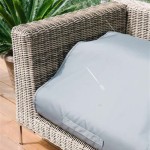```html
How To Keep Dogs From Peeing On Patio
Maintaining a clean and sanitary patio is a common concern for dog owners. Canine urination can lead to unsightly stains, unpleasant odors, and potential damage to patio surfaces. Understanding the reasons behind this behavior and implementing effective deterrents is crucial for preventing dogs from using the patio as a restroom.
Dogs may urinate on patios for various reasons. Scent marking is a primary driver, as urine contains pheromones that communicate information to other dogs. A previously soiled area, even if cleaned by humans, can retain residual odors detectable to a dog's sensitive nose, triggering repeat marking. Territoriality also plays a role, especially in multi-dog households or areas frequented by other animals. Anxiety or excitement can also lead to inappropriate urination. Furthermore, underlying medical conditions such as urinary tract infections or kidney problems can increase urination frequency and decrease bladder control.
Effective strategies for preventing patio urination involve a combination of cleaning, deterrents, and behavioral modification. A multi-pronged approach is often necessary to achieve lasting results, addressing both the existing scent markers and the underlying reasons for the dog's behavior.
Thoroughly Clean the Patio Surface
The first step in deterring patio urination is to eliminate existing urine odors. Standard household cleaners are often insufficient, as they may mask the smell for humans but not for dogs. Enzymatic cleaners specifically designed for pet urine are essential for breaking down the uric acid crystals that cause lingering odors. These cleaners contain enzymes that digest the organic matter in urine, effectively removing the scent and preventing repeat marking.
To properly use an enzymatic cleaner, first blot up any fresh urine with paper towels. Then, saturate the affected area with the cleaner, following the product's specific instructions. Typically, this involves leaving the cleaner on the surface for a specified period, usually 10-15 minutes, to allow the enzymes to work. After the dwell time, thoroughly rinse the area with water and allow it to air dry. Avoid using heat to dry the area, as this can set the stain.
For porous surfaces such as concrete or stone, multiple applications of the enzymatic cleaner may be necessary to fully penetrate the material and eliminate the odor. Consider using a pressure washer with a low-pressure setting to rinse the area after applying the cleaner. For particularly stubborn odors, a specialized concrete cleaner or degreaser may be required before using the enzymatic cleaner.
In addition to enzymatic cleaners, other cleaning agents can be used to disinfect the patio and remove surface stains. Diluted bleach solutions (always following safety precautions) can be effective for killing bacteria and removing discoloration. However, avoid using bleach on colored surfaces or areas where it could damage plants. Vinegar and baking soda can also be used as natural cleaning agents, although they may not be as effective as enzymatic cleaners for removing urine odors.
Employ Deterrents to Discourage Urination
Once the patio is thoroughly cleaned, employing deterrents can help discourage dogs from urinating on the surface again. Deterrents work by making the area less appealing to the dog, either through unpleasant smells, textures, or sounds. A variety of deterrents are available, and it may be necessary to experiment to find the most effective option for a particular dog.
Scent deterrents are a common choice. Dogs are often repelled by strong citrus scents, so applying lemon or orange peels around the patio can be effective. Commercial dog repellent sprays are also available, often containing blends of essential oils that are unpleasant to dogs. These sprays should be applied regularly, especially after rain, to maintain their effectiveness. However, be mindful of the ingredients in these sprays, as some may be toxic to other animals or harmful to plants.
Physical deterrents can also be used to make the patio less accessible or less appealing for urination. Covering the patio with a tarp or outdoor rug can prevent urine from soaking into the surface. Placing potted plants or other obstacles in areas where the dog tends to urinate can also deter them. Motion-activated sprinklers are another effective deterrent, as the sudden spray of water can startle the dog and discourage them from approaching the area.
Sound deterrents, such as ultrasonic devices that emit high-frequency sounds unpleasant to dogs, can also be used. These devices are typically motion-activated and emit a sound when the dog approaches. However, the effectiveness of ultrasonic deterrents can vary, and some dogs may become desensitized to the sound over time.
Supervision is also a powerful deterrent. When the dog is on the patio, closely monitor their behavior. If they start to sniff around, lift a leg, or show other signs of needing to urinate, immediately redirect them to their designated potty area. Praise and reward them when they eliminate in the correct spot.
It is critical to rotate deterrents periodically. Dogs can become accustomed to a particular deterrent over time, rendering it less effective. By switching between different types of deterrents, the dog is less likely to adapt to any one method, maintaining its effectiveness.
Establish a Designated Potty Area and Reinforce Positive Behavior
Training a dog to urinate in a designated area is fundamental to preventing patio urination. This involves establishing a specific spot in the yard where the dog is consistently taken to relieve themselves. This area should be easily accessible, away from high-traffic areas, and preferably covered with a surface that is appealing to the dog, such as grass or gravel.
Consistency is key when establishing a designated potty area. The dog should be taken to the designated spot frequently, especially after waking up, after meals, and before bedtime. When the dog eliminates in the correct spot, immediately praise them enthusiastically and offer a high-value treat. This positive reinforcement helps the dog associate the designated area with positive experiences, making them more likely to use it in the future.
Avoid punishing the dog for urinating on the patio. Punishment can create anxiety and fear, which can worsen the problem and lead to other behavioral issues. Instead, focus on rewarding positive behavior and redirecting the dog when they show signs of needing to urinate in the wrong place.
If the dog is already house-trained, retraining may be necessary to break the habit of urinating on the patio. This involves going back to the basics of house-training and consistently reinforcing the desired behavior. Use a leash to guide the dog to the designated potty area and wait patiently for them to eliminate. If they do not urinate after a reasonable amount of time, take them back inside and try again later. Avoid giving the dog free access to the patio until they have consistently used the designated potty area for several weeks.
For puppies or dogs with medical conditions, more frequent potty breaks may be necessary. Bladder control can vary depending on age, breed, and health status. Consult with a veterinarian to rule out any underlying medical issues that may be contributing to the problem.
In multi-dog households, it is important to ensure that each dog has its own designated potty area. Resource guarding can occur if multiple dogs are competing for the same spot. Separating the designated areas can help reduce competition and prevent territorial marking.
Furthermore, consider the composition of your dog's diet. Certain food ingredients or nutritional deficiencies can increase urination frequency or lead to urinary tract problems. Consult with a veterinarian or canine nutritionist to ensure that the dog is receiving a balanced and appropriate diet.
Addressing patio urination requires patience, consistency, and a multi-faceted approach. By thoroughly cleaning the patio, employing deterrents, and establishing a designated potty area, dog owners can effectively prevent their dogs from using the patio as a restroom and maintain a clean and sanitary outdoor space.
```
How To Build A Dog Potty Area Outside On Your Lawn

How To Stop Your Dog From Urinating On Concrete

Will Vinegar Stop Dog Peeing In The Same Spot Doctors

The 1 Selling Grass Litter Box For Dogs Potty Training Made Easy Porch Usa

Doggy John How To Build A Flushable Dog Run

2 X 3 Quick N Clean Potty Station W Pee Guard

Dog Grass Pad With Tray Artificial Patch Plants Pee Post For Dogs Potty Washable Puppy Turf Indoor Outdoor Full System To On Balcony Patio 35 4

12 Steps To Porch Potty Success Usa

Jack Cc S Pee Pit Yellow Brick Home

How To Keep Dogs From Peeing On Your Lawn And In Yard








